The Geographic Distribution Analyzed of the Four Tribes of Asteraceae (Anthemideae, Calenduleae, Inuleae and Senecioneae) in Iran
Somayeh Zarei1 * , Ahmad Reza Khosravi2 , Mostafa Mohammadi3 and farshad dargahi3
Corresponding author Email: zaree_somaye@yahoo.com
DOI: http://dx.doi.org/10.12944/CWE.10.Special-Issue1.75
The geographic distribution of the four selected tribes, Anthemideae, Calenduleae, Inuleae and Senecioneae (Asteraceae family) in Iran has been analyzed by using a dataset of 9633 georeferenced observations. All the observations and the richness of species was mapped with the point-to-grid richness analysis tool DIVA-GIS, using a 10 × 10 kilometer grid cell and the circular neighborhood option with a 50 km radius in all around Iran. Species of four selected tribes are distributed in the whole Iran. The 4 tribes in Iran have 54 genus, 269 species, 101 endemic species and 92 rare species. High species richness occurs in Fars, Tehran, East Azarbaijan, West Azarbaijan, Esfahan and Mazandaran. Ten 50 × 50 kilometer grid cells are needed to capture all the species which have the most conservative importance. The largest tribe between four tribes is Anthemideae with 143 species.
Copy the following to cite this article:
Zarei S, Khosravi A. R, Mohammadi M, Dargahi F. The Geographic Distribution Analyzed of the Four Tribes of Asteraceae (Anthemideae, Calenduleae, Inuleae and Senecioneae) in Iran. Special Issue of Curr World Environ 2015;10(Special Issue May 2015). DOI:http://dx.doi.org/10.12944/CWE.10.Special-Issue1.75
Copy the following to cite this URL:
Zarei S, Khosravi A. R, Mohammadi M, Dargahi F. The Geographic Distribution Analyzed of the Four Tribes of Asteraceae (Anthemideae, Calenduleae, Inuleae and Senecioneae) in Iran. Special Issue of Curr World Environ 2015;10(Special Issue May 2015). Available from: http://www.cwejournal.org?p=759/
Download article (pdf)
Citation Manager
Publish History
Select type of program for download
| Endnote EndNote format (Mac & Win) | |
| Reference Manager Ris format (Win only) | |
| Procite Ris format (Win only) | |
| Medlars Format | |
| RefWorks Format RefWorks format (Mac & Win) | |
| BibTex Format BibTex format (Mac & Win) |
Article Publishing History
| Received: | 2014-11-16 |
|---|---|
| Accepted: | 2015-12-30 |
Introduction
Most countries in all around the world put the attempt to determine the plant species which were under the endangerment of extinction. In Iran the list of flowering plant flora provided for conservation of nature was represented by Jalili and Jamzad in 1999. Iran is well known for its high diversity in flowering plant flora, with total number of ca. 4000 species, of which ca. 1400 are endemic (Jalili A. and Jamzad, Z., 1999). Since the observation about plant species in ecology could be mentioned as a very important factor in the assessment of current situation, so that is a new approach, the assessment about the biodiversity has been mentioned as the tool for the observation of ecosystem condition, plant species and biodiversity in plant species. The necessity of biodiversity and protection from its which are mainly mentioned as the sustainable exploitation from the biological resources. The protected regions are the very saves of the biodiversity in the biogeography units (Hijmans, 2000). In this relation, the geographical data with the high capability for protecting the data and representing the new standards as the efficient tools could be represented in the environmental planning. Through this, various capabilities in the field of data collection, data edition, data analysis and modeling have been represented which these could be as the useful tools for planning the facts in this field. For the first time in middle of 1960 decade, the activities on the first geographical system were started. These data were used more which this was only due to the fact that these data were various in spectra, cheap which they also involved many other capabilities which today the study about the geology and the factors for the formation of it have been got extensive in all over the world. (Bioversity International, 2009). Various studies in this field have been provided which we could only mention some of them: Maxted et al. in 2004 provided a study similar to study of the Hygman et al. which this study was accomplished on the geographical taxonomy of Vigna. Through their study, the taxonomy of all the Vigna species in Africa was specified by which the regions rich of the speices and the hot regions were all specified (Maxted et al., 2004). Maxted in 2004 provided the study on the richness diversity of Aegiops and its protection using GIS regulation. They specified the hot regions and specified the regions in Turkey, Lebanon, Syria and Palestine specified (Maxted et al., 2004). Also, Sunil in 2009 provided the study about the richness of diversity about Jatropha curcas L. using GIS regulation. This plant could generate the oil which is used in saponification (Sunil et al., 2009). According to the geographical circumstances of Iran, it could be stated that Animal life and vegetation are diverse in all over Iran. The diversity relies on the weather condition. In Iran, there are nearly 4000 species, varieties and subspecies. There are over 1727 species of Exclusive Plants in Iran which this criterion includes 22% of all the flora in Iran (Attar et al., 2004; Jalili A. and Jamzad Z., 1999). In present paper, Asteraceae has been studied which this species is commonly referred to as the aster, daisy, or sunflower family, is an exceedingly large and widespread family of Angiospermae. The group has more than 23,000 currently accepted species, spread across 1,620 genera and 12 subfamilies. In terms of numbers of species, Asteraceae is rivaled only by Orchidaceous. (Which of the two families is actually larger is unclear, owing to uncertainty about exactly how many species exist in each family). The main feature of the family is the flower type in the form of capitula surrounded by involucres bracts. The name "Asteraceae" comes from Aster, the most prominent genus in the family that is connected with its inflorescence star form. This family has a remarkable ecological and economical importance, and is present from the Polar Regions to the tropics, colonizing all available habitats. The Asteraceae may represent as much as 10% of autochthon flora in many regions of the world. Most members of Asteraceae are herbaceous, but a significant number are also shrubs, vines and trees. The family has a worldwide distribution, and is most common in the arid and semi-arid regions of subtropical and lowers temperate latitudes. Asteraceae have a cosmopolitan distribution, and are found everywhere except Antarctica and the extreme Arctic. They are especially numerous in tropical and subtropical regions (notably Central America, eastern Brazil, the Andes, the Mediterranean, southern Africa, central, and southwestern China). In present paper, Asterales order, Asteraceae family, (Asteroideae, Arctotideae, Anthemitheae, Astereae and Calenduleae) would all be observed. in 1946 volume 154 of flora Iranica about the Anthemideae was published (Georgiadiou et al., 1980). In 2004, volume 59 of flora about Anthemideae (Podlech D., 1986), also in 1949 volume 164 of Flora Iranica about Calenduleae, Arctotideae (Mozafarian Vali olah, 2008) was published in Iran. Based on the studies accomplished in this base, there is no study on the basis of the biodiversity about the species related to tribes "Anthemideae", "Calenduleae ", "Inuleae" and "Senecioneae". Hence, in present paper it has been attempted to provide the analysis about the expansion of area related to the tribes "Calenduleae ", "Inuleae ", "Anthemitheae ", and "Senecioneae ".
Materials and Methods
Create Data Bank and Georefrence
Firstly, the study on the basis of the Flora about four tribes from Asteraceae including Anthemideae, Calenduleae, Inuleae and Senecioneae was provided in which the information such as the name of species, tribe, family and height were entered in the informational database from five volume flora as following: Podlech et al. (1946), Grierson and Rechinger (1942) (Dittrich et al., 1989), Georgiadiou et al. (1940), Dittrich et al. (1949) And the information database of plant Herbarium of Shiraz University. To develop the information database from Access program chosen from Microsoft office, it has to be stated that the data bank has been developed from a number of fields including the name of family, tribe, species and subspecies, variety, the collection location, the height of location, geographical length and width. The information related to each species were entered in the data bank which the entire data bank involved 10640 records throughout Iran. In present paper, Through Geographic information system (GIS), the data bank including the geographical characteristics of the tribes Anthemideae, Calenduleae, Inuleae and Senecioneae made in Iran would be analyzed.
Geographical Analysis with Diva-GIS Software
Also, in present paper the statistical approaches were accomplished on the species. For any species, the geographical area was estimated in Iran which through the Grid Cells, all the observations and the richness of species was mapped in all around Iran. Through this, the grid cells involving all the species were specified and the relation between the richness of species with the geographical width was specified. In present paper, GIS was used for giving description about all the geographical area of Asteraceae species in Iran. Accordingly, all the registered patterns in data bank were devoid of geographic coordinates. To find the geographic coordinates, the maps of GIS provided for Iran including all the ways and the maps for the regions in Iran were used in MapInfo and Google Earth. The species mentioned in data bank were tabled in terms of Provinces. To assess the collection density in terms of province, the average of all the observations was computed for any species. Meanwhile, the maps provided for the observations and the number of species was depicted via Diva-GIS software. The expansion for the spread of any species was estimated - for this two statistical approaches 1- Max D, maximum distance between two observations of a single species was calculated as the largest distance (in kilometers) between all possible pairs of observations of one species. 2- CAr, circular expansion, we assigned a circular area (CA50) with a radius 50 km to each observation and calculated the total area of all circles per species were used. Such studies based on the obtained data from the GIS analyses could be used more for providing the analyses about the protection and using the species of Asteraceae family in this case the studies could be also used for the geographic area of the species.
Results
The Expansion Areas for Anthemideae Based on the Provinces of Iran
We recorded a total of 9633 georeferenced data set to Shiraz University’s Herbarium data base. From Anthemideae tribe, 6076 records were Geo-referenced which it was the most records in the data bank among 4 tribes have been reported, it also has been reported that this tribe involves 14 genus and 143 species in Iran. From the large genus of this tribe, we could mention the Anthemis, Tanacetum, Artemisi and Achillea with 34 species, 35 species, 33 species and 19 species, respectively. High species richness in the Anthemideae tribe occurs in Mazandaran, West Azarbaijan and East Azarbaijan with more than 53 species (Figure 1a).
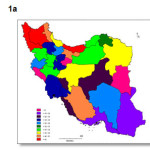 |
Figure 1a: The number of species richness for Anthemideae tribe in Iran based on province. |
Among the four tribes studied in present paper, it has been mentioned that tribe "Anthemideae" in Iran involves the expansion areas and extensive geographic fields. The species of this tribe have been observed in all over Iran. Over 564 cases about the species of this tribe have been observed in the provinces Fars, west Azerbaijan and Tehran (Figure 1b). Generally, it could be stated that the comparison between the maps of the provinces based on the number of species could be observed in these maps.
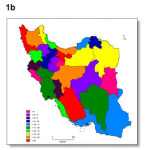 |
Figure 1b: The number of observations for Anthemideae tribe in Iran based on province. |
The Expansion Areas for Calenduleae Based on the Provinces of Iran
From Calenduleae tribe, 277 records were Georeferenced which these records have been registered in the information database of plant Herbarium of Shiraz University. According to the obtained statistics from the information database of plant Herbarium of Shiraz University, it has been reported that this tribe involves 2 genus and 9 species in Iran. The largest genus in this tribe is the Calendula L. with 4 species in Iran. High species richness in the Calenduleae tribe occurs in Fars, Bushehr and Khozestan with more than 4 species (Figure 2a).
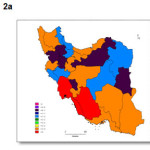 |
Figure 2a: The number of species richness for Calenduleae tribe in Iran based on province. |
The Taxons for this tribe have been observed in all the provinces in Iran, surely all the cases observed for this tribe have been reported negligible. In the provinces Fars, Bushehr and Khuzestan the most cases about this tribe have been observed which in these three provinces, over 30 cases have been observed, which 9-30 cases related to this tribe have been observed in the provinces Hormozgan, Kohgiluyeh and Boyer-Ahmad and Golestan. (Figure 2b).
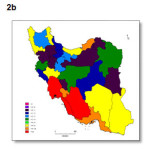 |
Figure 2b: The number of observations for Calenduleae tribe in Iran based on province. |
The Expansion Areas for Inuleae Based on the Provinces of Iran
From Inuleae tribe, 2239 records were Georeferenced, it has been reported that this tribe involves 30 genus and 46 species. High species richness in the Inuleae tribe occurs in Fars, Makran and Kerman, with more than 27 species (Figure 3a).
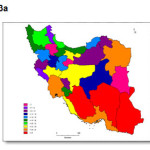 |
Figure 3a: The number of species richness for Inuleae tribe in Iran based on province. |
Among all the tribes observed in this paper, the most observations have been accomplished about the tribe Inuleae. The most observations related to the taxons of this tribe, over 150 observations have been observed in the south provinces of Iran – Fars, Bushehr and Hormozgan. In this case, it has to be stated that 90-150 observations have been accomplished in the provinces Kerman, Sistan and Baluchistan, West Azerbaijan. Fewer observations have been observed in the provinces Qom, Ilam and Kermanshah (Figure 3b).
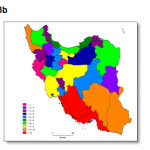 |
Figure 3b: The number of observations for Inuleae tribe in Iran based on province. |
The Expansion Areas for Senecioneae Based on the Provinces of Iran
From Senecioneae tribe, 1041 records were Georeferenced, it has been reported that this tribe involves 4 genus and 31 species. High species richness in the Senecioneae tribe occurs in Fars, Tehran and Mazandaran, with more than 14 species (Figure 4a).
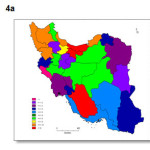 |
Figure 4a: The number of species richness for Senecioneae tribe in Iran based on province. |
The tribe “Senecioneae” among other four tribes is the tribe which the most observations have been reported about it. Over 75 cases of this tribe have been observed in the provinces Tehran, Fars and Mazandaran. The provinces Isfahan, Kerman and west Azerbaijan are the provinces at which more observations have been accomplished as well (Figure 4b).
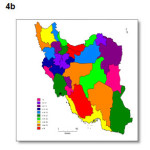 |
Figure 4b: The number of observations for Senecioneae tribe in Iran based on province. |
The Expansion Areas on the Basis Of Grid Cells for the Species of Anthemideae Tribe
Through The observation of the grid map based on the number of observations and species, the conclusion has been reported by which it could be stated that there is difference between the hotspots based on the number of observations and the hotspots resulted about the species richness, which the points related to hotspots are not overlapped ever. In figure 9, it could be observed that the hotspots based on the observations provided about the provinces Mazandaran, Tehran, and Fars are the points which have been concentrated, whereas the hotspots based on the number of species in province Fars – have not been observed which these points show the high number of species. In this relation, it has to be stated that the cases about this tribe have been observed more in Tehran which in other provinces like Mazandaran, Guilan, Zanjan, Ardabil, west Azerbaijan, east Azerbaijan, and the hotspots have been observed more as well. Within the increase of observing the hotspots in provinces east Azerbaijan, Guilan and Ardabil, the possibility to identify the new species is very high in these regions (Figure 5a, b).
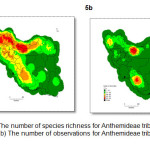 |
Figure 5: a) The number of species richness for Anthemideae tribe in Iran based on grid cells. b) The number of observations for Anthemideae tribe in Iran based on grid cells. Click here to View figure |
The Expansion Areas Based on Grid Basis for Calenduleae in the Provinces of Iran
The hotspots in the grid map based on the observations for tribe Calendulea have been mainly observed in the southern part of Iran in Fars and Bushehr provinces. In this relation, it has to be stated that the species hotspots have been overlapped the spots provided in this figure which the hotspots have been extensively observed in Fars Province (Figure 6a, b).
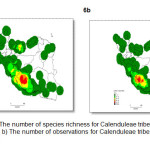 |
Figure6: a) The number of species richness for Calenduleae tribe in Iran based on grid cells. b) The number of observations for Calenduleae tribe in Iran based on grid cells. Click here to View figure |
The Expansion Areas Based on Grid Basis for Inuleae in the Provinces of Iran
The highest concentration of hotspots based on the observations accomplished about the various taxons of this tribe have been categorized in Fars province, but the species hotspots are more extensive for this tribe which the provinces Fars, Tehran and Mazandaran are the provinces at which the species hotspots have been observed. Also, in the provinces Lorestan, Hamedan, Kerman and Markazi, however, less observations have been accomplished there are high level of speices richness, which it could be stated that the possibility of increasing the species richness would be probable. For this, refer to figure 7a and 7b.
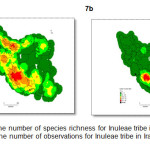 |
Figure7: a) The number of species richness for Inuleae tribe in Iran based on grid cells. b) The number of observations for Inuleae tribe in Iran based on grid cells. Click here to View figure |
The Expansion Areas Based on Grid Basis For Senecioneae in the Provinces of Iran
Through The observation of the grid map based on the number of observations and species, the conclusion has been reported by which it could be stated that the points in the map have been overlapped the hotspots, which this fact could be observed in the provinces Tehran, Mazandaran and Fars. However, the low observations accomplished in the province Kermanshah, the highest species richness could be observed in this case, which this province is mentioned for the increase of species richness (Figure 8a,b).
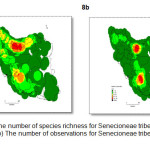 |
Figure8: a) The number of species richness for Senecioneae tribe in Iran based on grid cells. b) The number of observations for Senecioneae tribe in Iran based on grid cells. Click here to View figure |
Discussion
Here for the first time species of Asteraceae family in Iran (four tribes) are systematically analyzed, by using GIS. Some of our records are recent, but many data back many years (mentioned only in available Floras). In present paper, four tribes such as Anthemideae, Calenduleae, Inuleae and Senecioneae from the Asteraceae in Iran have been observed. These tribes involve 54 genus and 269 species. The obtained data related to these tribes on the basis of taxonomy and floristic have been obtained. Along this, it has been reported that no analysis on the expansion for geogrpahic area and geographic plant has not been accomplished in Iran. Here, through the GIS, geo-referenced data bank from the locations which the speices for four tribes in Iran provided was analyzed. In present paper, the statistical appraoches related to the species were used. In this case, it has been stated that the expansion area was estimated whihc through the grid cells, the observations and the species richness was mapped. Through this, the number of gird cells including all the species was specified and the relation between species richness with the geogrpahic width was specified. In presnet apper, the speices richness was utilzied, which the speices richness provided for the assessmnet with the extensive application for the diveristy of taxonomy in this base (Hijmans R. J. and Spooner D. M., 2001). According to the local analysis from the four tribes speices, it has been stated that the species like Tanacetum polycephalum, Achillea wilhelmsii, Tanacetum parthenium, Anthemis pseudocotula, Achillea eriophora, Anthemis odontostephana, Achillea biebersteinii, Anthemis gayana, Tripleurospermum disciforme, Calendula persica are the most abundant species. Also, The species like Tanacetum polycephalum, Anthemis wilhelmsii, Anthemis pseudocotula, Tanacetum parthenium, Achillea eriophora, Anthemis odontostephana, Achillea biebersteinii, Anthemis gayana, Tripleurospermum disciforme, Calendula persica, Anthemis persica, Gundelia tenuisecta, Achillea tenuifolia and Hertia angustifolia are the species which respectively 319, 309, 224, 224, 213, 204, 201, 144, 173, 164, 159, 157, 154, and 151 cases of these species were observed in these four tribes. Obviously, it has been stated that despite many studies accomplished on the tribes of Asteraceae family, no complete study in this base has been reported. This is due to the fact that access to the remote area is a difficulty; surely there are other species in the country which botanists are not aware of these species. According to the local analysis from the four tribe's speices, it has been stated that the species Senecio glaucus with 412 cases has been observed and introduced as the most abundant species in the expansion area. Obviously, it has been stated that despite many studies accomplished on the tribes of Asteraceae family, no complete study in this base has been reported. This is due to the fact that access to the remote area is a difficulty; surely there are other species in the country which botanists are not aware of these species.
References
- Attar, F. and Hamzeh’ee, B. & Ghahreman, A. "A contribution to the flora of Qeshm island, Iran." Iranian Journal of Botany., 10 (2): 199-218. (2004).
- Bioversity International: Geographic Information Systems (GIS) http://www.bioversityinternational.org.scientific_information.information_sou (2009).
- Dittrich, M., Nordenstam, B. and Rechinger, K. H. Compositae VII. In: Rechinger, K. H. (ed.). Flora Iranica. Vol. 164. Compositae VII. Graz, Austria: Akademische Druck-u. Verlagsanstalt (1989).
- Georgiadiou, E., Lack, H. W., Rechinger, K. H. and Wagenitz, G. Inuleae. In: Rechinger, K. H. (ed.). Flora Iranica. Vol. 145. Compositae IV - Inuleae. Graz, Austria: Akademische Druck-u. Verlagsanstalt (1980).
- Hijmans, R. J., and Spooner, D. M. "Geographic distribution of wild potato species." American Journal of Botany., 88(11): 2101-2112. (2001).
- Hijmans, R. J., Garrett K. A., Huama´n, Z., Zhang, D. P., Schreuder, M., and Bonierbale, M. "Assessing the geographic representativeness of gene bank collections: the case of Bolivian wild potatoes." Conservation Biology., 14: 1755-1765. (2000).
- Jalili, A. and Jamzad, Z. Red Data Book of Iran, Tehran, Iran: Research Institute of forest & Rangelands (RIFR), 748 p. (1999).
- Maxted, N., Mabuza Dlamini, P., Moss, H., Padulosi, S., Jarvis, A. and Guarino, L. ″An Echogeographic Study African Vigna.″ Systematic and Echogeographic Studies on Crop Genepools., Rome, Italy: International Plant Genetic Resources Institute (2004).
- Mozafarian, Flora in Iran, Echiropeae, Anthemideae tribes, Compositae family, Tehran (2008).
- Podlech, D. Artemisia. – Pp. 159-223 in: Rechinger, K. H. (ed.), Flora iranica 158. (1986).
- Sunil, N, Sivaraj, N., Anitha, K., Babu, A., Vinod, K., Sudhir, E., Vanaja, M., and Varaprasad, K. S. "Analysis of diversity and distribution of Jatropha curcas L. germplasm using Information System (DIVA-GIS)." Genet Resour Crop Evol., 56:115–119. (2009).






